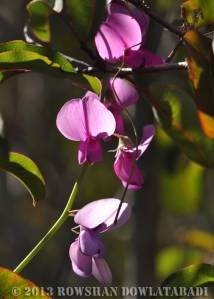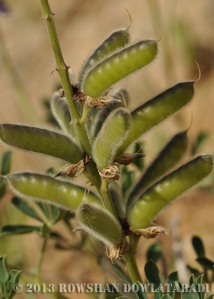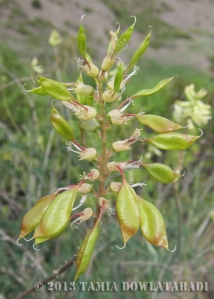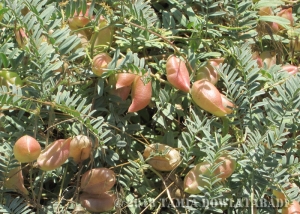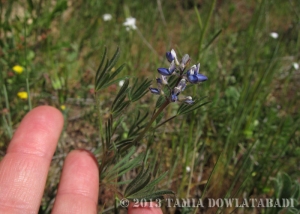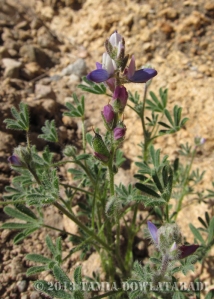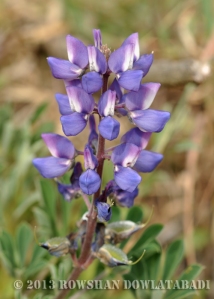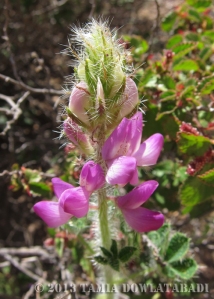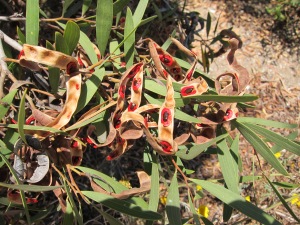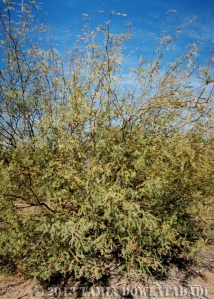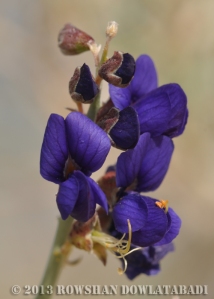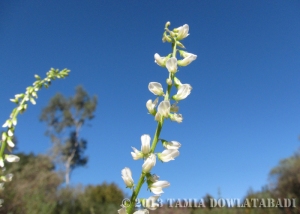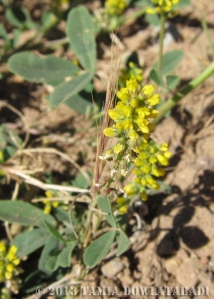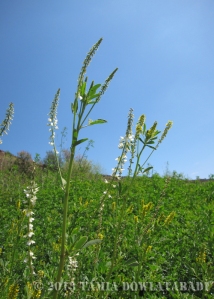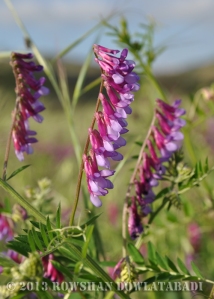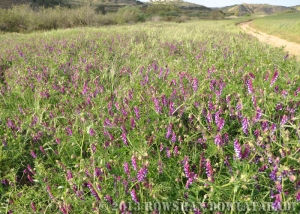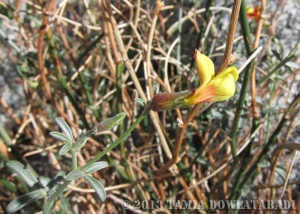Spring in San Diego is the time for fabulous fabaceae flowers. I was looking forward to writing about the pea family because there are so many pretty flowers to illustrate it with. They are blooming like crazy. The banks of Lake Hodges are covered with white and yellow sweet clover. Purple spears of lupines have shot up along the highway and hot pink wild pea flowers dangle from chaparral trees.
Pea flowers are very easy to identify. They have 5 petals: one big one at the top that makes a sail (called a banner), 2 to the side that are called the wings, and 2 that are fused together to make the keel.[1] Basically, the pea flower looks like a magic flying boat. The flower sizes range from large wild pea (Lathyrus vestitus var. alefeldii) flowers to the many tiny flowers that make the clover head’s “petals.” Their leaves are often pinnate which means they are made up of 2 opposing rows of leaves, though lupine leaves have a very recognizable palmate form where the leaves radiate from a central point. Another notable feature is their pea pods.
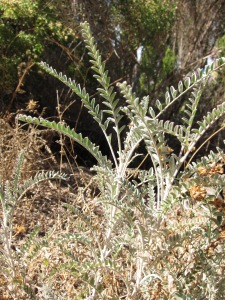
Many plants in the pea family including this coast locoweed (Astragalus trichopodus var. lonchus) have pinate leaves.
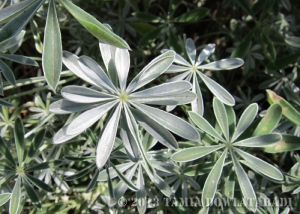
Lupines are pretty even when they aren’t in bloom. These palmate leaves are probably of a silver bush lupine (Lupinus albifrons)
Fabaceae makes up the 3rd largest land plant family behind Orchidaceae and Asteracea. The name comes from the Latin Faba which means beans[2] (think of the redundant fava beans).
The first local pea I noticed last year was Astragalus trichopodus var. lonchus. It has funny bulbous pea pods. I was really excited when I looked it up because I had just learned that Astragalus is an excellent immune system builder in Asian medicine. In a perfect example of knowing just enough knowledge to be dangerous, I didn’t realize at the time that there were about 3000 different species of astragalus plants[3]. A bit of research quickly revealed that many of the American astragalus plants contain toxins. Astragalus trichopodus has the common name of coast locoweed. Some locoweeds produce a toxin called swainsonine which poisons livestock. Others are poisonous because they accumulate selenium.[4] Another astragulus plant in San Diego is the Parish milkvetch (Astragalus douglasii).
When I think of lupines, I think of gorgeous photos of snow-capped Mt. Ranier, a bright blue sky, and meadows of purple lupines. (Unfortunately, I don’t have a photo of it.). Lupines can be recognized even when they are not in bloom by their palmate leaves. There are several lupines in San Diego. We found miniature lupines (Lupinus bicolor), Bajada lupines (Lupinus concinnus) and stinging lupines (Lupinus hirsutissimus).
Certain types of lupines have edible beans (or rather edible after processing). They were eaten in ancient Rome, but they seem to be making a comeback. One web site that called them “miracle beans” and listed various conditions they purportedly helped with.[5] According to www.lupini.us, they are second to only soy beans as a great source of protein for vegetarians and contain “the full range of amino acids.”[6] However, since the beans contain toxic amounts of alkaloids they need to be specially processed.
Of course, there are peas, beans, and peanuts in the Fabaceae family, but I didn’t find any growing in the wild, or in my garden since I didn’t plant them this year.
There are fabaceae trees as well. I couldn’t help but notice an Acacia saligna—Willow Acacia next to the World Beat Center ethnobotanical garden. I’ve seen them from a distance in other places as well. I glanced at it without realizing it was a fabaceae since its pom-pom flowers didn’t look pea-like at all. It is an invasive plant, as is the cyclops acacia which I found in the Tijuana River area. Both came from Australia. There is also the western cowboy BBQ evoking mesquite (Prosopis glandulosa var. torreyana) The beautiful smoke tree (Psorothamnus spinosus) and indigo bush (Psorothamnus schotti) are both found in the desert and have beautiful purple flowers.
Clovers are secret Fabaceae plants. Their clover flowers are not actual flowers but rather bunches of tiny flowers. Sometimes they are so small it is hard to tell they are individual flowers rather than petals. Red clover has been used for a variety of health purposes including as an expectorant, for skin problems, as an anti-inflamatory and even as a cancer treatment. In other places I’ve lived there was red clover all over the place. Here I could only find some sad white clover in park lawns.
The main native clover species here is the sweet clover. Instead of round heads of tiny clover flowers, the flowers grow on a stalk. This flower has been used by Native Americans for colds, a bed bug repellant, for pimples, and for sunburn. [7] White sweetclover (Meliltus alba), Indian sweetclover (M. indicus), and yellow sweet clover (M.officinalis) can all be found in the San Diego area. Caution must be taken with clovers because they contain coumarins which are the natural compound that the blood thinner coumadin was based on. If the clover becomes moldy, the coumarin can convert to dicoumaraol which can lead to internal bleeding.[8]
Pea plants play an important role in the ecosystem. They are nitrogen fixers. This means they have a symbiotic relationship with bacteria that live in nodules on their rots systems and create nitrogen compounds which are used by the plant. When the plant dies this nitrogen is released into the soil and other plants can use it.[9] This mad rush of pea plant blooms which makes the landscape a rainbow, fades and dies and then helps other plants grow. So, even though many of these plants are toxic to humans and animals, they still are important for the world. Perhaps their toxicity keeps them in the ground so they can flower and then go back to the soil and help the other plants.
Fabaceaes seem to range from important food staple to important medicine to poisonous. It seems that even though they are plentiful, I probably won’t be harvesting any for personal use or casually nibbling any on the trail. I’ll leave that to the experts. However, enjoying the flowers is always safe.
References
[1] Elpel, T. J. Botany in a day, the patterns method of plant identification. Hops Press, LLC, 2004. Print.
[2] Wikipedia contributors. “Fabaceae.” Wikipedia, The Free Encyclopedia. Wikipedia, The Free Encyclopedia, 10 Mar. 2013. Web. 3 Apr. 2013.
[3] Wikipedia contributors. “Astragalus.” Wikipedia, The Free Encyclopedia. Wikipedia, The Free Encyclopedia, 26 Mar. 2013. Web. 3 Apr. 2013.
[4] Wikipedia contributors. “Locoweed.” Wikipedia, The Free Encyclopedia. Wikipedia, The Free Encyclopedia, 7 Mar. 2013. Web. 3 Apr. 2013.
[8] Wikipedia contributors. “Melilotus officinalis.” Wikipedia, The Free Encyclopedia. Wikipedia, The Free Encyclopedia, 21 Feb. 2013. Web. 3 Apr. 2013.
[9] Wikipedia contributors. “Nitrogen fixation.” Wikipedia, The Free Encyclopedia. Wikipedia, The Free Encyclopedia, 27 Mar. 2013. Web. 3 Apr. 2013.
